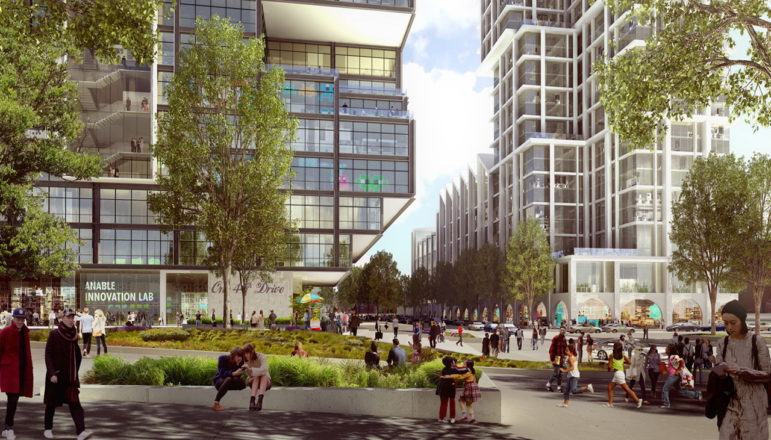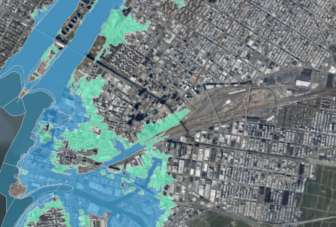
A rendering of the proposed TF Cornerstone project in a press release from the Economic Development Corporation.
The Long Island City rezoning study has been moving slowly, with no public meetings held since last summer. In the meantime, much attention has turned to nearby waterfront parcels, where several projects have been proposed by private developers and by the city. This comes as much of the Long Island City waterfront to the south has already been redeveloped with river-facing towers.
Over the past couple months, a recently formed group called the Long Island City Coalition, backed by other community groups and elected officials, have held rallies to protest the Economic Development Corporation’s selection of TF Cornerstone to develop two waterfront parcels, decrying TF Cornerstone’s plan as one that would “add thousands of new housing units to an already developed neighborhood” and one that lacks “any meaningful public review and input.”
A press release for a rally describes the TF Cornerstone project as “one of seven segmented and unrelated large rezonings now at play in Long Island City.” The group identified for City Limits seven particular projects or rezoning proposals (eight, if you include two that overlap with each other), the majority of which would require city approval, though a few sites were already zoned residential and could potentially still be redeveloped without a rezoning. There are, of course, also myriad development projects in Long Island City that are “as of right,” meaning they do not require permission from the city or a zoning change to build.
City Limits mapped those eight projects and found them to be in various stages, with development plans still vague in some cases, and others already in or nearing the public review process. One would not include housing: The city is considering redeveloping a Board of Education office building near the waterfront into a biotech hub as part of the mayor’s $500 million LifeSci NYC Initiative.
Several are expected to include not just housing, but a variety of other uses, including schools, parkland, and commercial and industrial space. In particular, the EDC calls the TF Cornerstone project a “first of its kind work-live-play structure” that will include light industrial space (of which half will be affordable and co-developed by a nonprofit), office space and an “Arts and Technology Accelerator,” a workforce development center, retail space, artist space, open space and a school. There will be housing, too—1,000 apartments, of which 25 percent would be income-targeted.
Click on a shape to see the details of a particular project or rezoning.
But the coalition argues that the cumulative impacts of these projects are not being taken into account, and that the city should initiate a “comprehensive planning” process for the entire neighborhood (and rejects the notion that the Long Island City Core Neighborhood Planning Study can deliver that). The group has also gathered nearly 1,300 signatures on a petition calling for an alternative plan for those parcels and others along the waterfront—a plan that emphasizes open space and amenities without housing.
Jimmy Van Bramer, who as the local councilmember bears significant sway over the approval of any rezonings, has attended the group’s rallies and urged the EDC to reconsider their proposal and take into consideration the community’s concerns about open space, affordability, and density.
“Long Island City residents are living with the outcomes of rezonings that aren’t comprehensive and don’t take into account the whole neighborhood or the whole of the community’s needs,” he said in an e-mail to City Limits. “The rezonings that were put in place before my time in office were not thoughtful about how the need for city services, particularly schools and transportation, would grow exponentially. The city needs to take a comprehensive approach to planning, zoning and development in this neighborhood. As of right now, I am refusing to consider any rezoning in my district until my and my constituents’ concerns about development’s effects on city services are properly taken into consideration.”
Wanted: more than housing
Last year, Long Island City received the distinction of having gained more apartments than any other neighborhood in the country since the Great Recession. A report released last week by the Long Island City Partnership, a local development corporation, found that from 2006 to today about 15,700 apartments have built, with another 6,200 expected to be completed by 2019 and yet another 10,200 proposed or under construction that would be completed after 2020. As City Limits has previously reported, the neighborhood already underwent several rezonings under the Bloomberg administration, which generated far more apartments than expected and, community residents complain, far too few amenities.
But business advocates say this is starting to change. The LIC Partnership report notes that the neighborhood also gained 1.2 million square feet of industrial and commercial space in the past year, and expects 5.3 million square feet in the coming years. That’s in addition to the creation of 160,000 square feet of retail space over the past year, with another 536,000 square feet to be built by 2021.
“This year’s Neighborhood Snapshot perfectly captures our dynamic, mixed-use, live/work community that’s coming into focus,” wrote Elizabeth Lusskin, president of the LIC Partnership in a press release last week. “While previous Snapshots showed rises in individual sectors, this report revealed tremendous growth across all sectors in Long Island City.”
The de Blasio administration has also said it aims to promote the development of a “mixed use” neighborhood. That’s one of the professed goals of the de Blasio administration’s Long Island City Core rezoning study, though a specific rezoning strategy has still yet to be announced. There have been no updates on the study since September.
The Economic Development Corporation and TF Cornerstone also argue that their proposal for the two city-owned waterfront lots is bringing many of the benefits the community is asking for.
“TF Cornerstone is committed to working with the community, local elected officials, and the city to ensure that the LIC Innovation Center is a development on public land for the public good,” wrote Jon McMillan, director of planning for the developer, in an e-mail to City Limits. “The site currently includes a parking lot, garage, and a dilapidated, unsafe waterfront — it is in need of significant investment, but can be transformed to deliver great public benefits for the community. The city’s vision for the site is to create a hub for good-paying industrial and innovation jobs in Long Island City, complete with workforce development training, a new 600-seat 80,000-square-foot school, 100,000 square feet of affordable manufacturing space, affordable apartments, local cultural space, and a resilient, public waterfront for the neighborhood to enjoy.”

NYC Flood Hazard Mapper
Floodplain according to preliminary draft of new FEMA maps. Blue is the 100-year floodplain (where there is a one percent chance of flooding each year and where special building codes are required) and green is the 500-year floodplain (where there is .2 percent chance of flooding every year).
The Economic Development Corporation similarly emphasized the mixed-use nature of the site, writing “We’re proud that this project will build on Long Island City’s industrial heritage with space for new industrial jobs and workforce training, as well as hundreds of affordable apartments,” along with a school and an acre of waterfront open space. The city will remain owner of the land but will lease the site to TF Cornerstone; EDC did not answer requests for information on the cost of the lease by press time.
But the LIC Coalition says it wants to see that public land turned into a wetland park and community recreation center, with plenty of grassy open space to act as a flood buffer.
The LIC Post has reported that TF Cornerstone buildings will raise the site by thirteen feet, as required by building codes in flood zones. But the coalition argues that a raised site “will accelerate the destructive effects of water seeking its own level during a surge and simply inundate points further inland by going around the wall” and that “a moratorium on waterfront development proposals must be implemented until a comprehensive plan that addresses the climate change and sea level rise vulnerabilities along the Brooklyn/Queens East River waterfront is adopted.”
Using the city-owned sites for a large park and habitat restoration site, says Thomas Paino of the Hunters Point Community Coalition (also a member of the LIC Coalition), “helps to protect the upland community from sea level rise, and it provides the desperately needed open space. If all of these projects get built, we will be heading very rapidly to the worst [open space] ratio in the city.”
As of 2015, Long Island City and Woodside has the 43rd lowest ratio of park and playground acres to residents out of 51 neighborhoods, according to New Yorkers For Parks City Council District Profiles.

NYC Flood Hazard Mapper.
Expected floodplain in 2050, using preliminary FEMA maps plus climate change predictions. Blue is the 100-year floodplain (where there will be a one percent chance of flooding each year in 2050) and white is the 500-year floodplain (where there will be a .2 percent chance of it flooding every year in 2050). Read more on the debate about developing in NYC’s flood zones here.
The coalition also thinks that the adjacent Board of Education building that the city is considering for a biotech hub, “has the potential to provide more school seats than any other currently proposed school,” and could also include artist and light manufacturing space, a cultural center, a climate change educational center, job training, space for non-profits, and other benefits.
The School Construction Authority’s 2018 update to the 2015-2019 capital plan says the district needs 2,028 seats, and that 1,720 have been funded. Such calculations take into account expected housing development, but are disputed. Asked about school overcrowding, Van Bramer said in an e-mail to City Limits that he’s secured funding for 14 new schools with 5,000 seats but that the neighborhood is still “in desperate need of schools” due to the rapid pace of development and needs more seats than the city is currently planning.
The group is also concerned about the displacement of residents, local businesses and artists, and that the proposed affordable housing will not be sufficiently affordable to low-income residents. “There is no evidence to support the idea that this type of development will preserve small manufacturing, the arts, or existing retail. Historically the opposite is true. What it does is continue to attract designers, photographers, tech companies, and retail start-ups being priced out of Manhattan,” writes the group.
But community advocates and elected officials across the city have also argued that, if the city needs to grow its housing stock to accommodate new residents, the city should focus on rezoning not just low-income neighborhoods, where many residents may bear the risk of displacement, but higher-income ones too. If that’s the order, Long Island City is certainly a prime location: Having lost low-income residents in recent years, the neighborhood had the 10th highest average median income among city neighborhoods in 2015, according to the New Yorkers for Parks report.
Concerns about cumulative impacts, spreading effects
The LIC Coalition is also concerned that the city is not measuring the “cumulative” impacts of the multiple rezonings and redevelopment projects underway. Community Board 2 also demanded a cumulative assessment in its recent comments about the major waterfront rezoning on the adjacent property proposed by the local manufacturer and developer Plaxall.
The Department of City Planning said in an e-mail to City Limits that in its analysis of each project, the city carefully takes into account all quantifiable planned and projected development to ensure an understanding of cumulative impacts. The agency says the Department of City Planning and the Mayor’s Office, which will be overseeing the environmental review process for the Plaxall and TF Cornerstone rezonings respectively, will be closely coordinating to ensure cumulative impacts are analyzed.
The city’s environmental review process, however, does not involve an analysis of the change in conditions from before all development within a given time period occurs to after all that development occurs. Rather, for each project that goes through environmental review, other projected or planned developments are incorporated into the “No Action” or baseline scenario. And, as pointed out by land use expert George Janes, when analyzing the impacts of a project on something like school overcrowding, the environmental review manual only deems an impact to have a “significant adverse impact” if there is a certain degree of change from the No Action, baseline scenario—meaning that the full extent of the change from prior to both projects to after both projects is not evaluated.
The city does have other capital planning processes outside the environmental review process to evaluate whether a neighborhood, over time, needs new infrastructure. But city resources are limited, which means that ultimately, the city must make tough choices about when to promote growth to accommodate new residents and when to scale back development to prevent stresses on infrastructure.
Large-scale development is a possibility not just for the waterfront but also on Long Island City’s eastern edge. The city is still considering decking over Sunnyside Yards and building a massive new mixed-use development there. This March, it chose a designer to create a master plan for the area.
Meanwhile, further east along the 7 line, a number of groups concerned about displacement recently launched the 7 Train Coalition to develop community plans for their neighborhoods and fight for policy changes around issues like landlord harassment and policing. Michael Forest of the Queens Anti-Gentrification Project says that while mid-western Queens is certainly not growing like Long Island City, the coalition has noticed priced-out Brooklynites moving to the area, rising rents, the arrival of higher-priced stores, development projects along Roosevelt Avenue and Queens Boulevard, and a church seeking to build a larger, five-story church in Woodside.
But amid the sea of proposed projects that advocates fear might hasten gentrification in LIC and environs, at least one controversial project looks unlikely to materialize: The Brooklyn Queens Connector, another project that might have catalyzed growth—and, some worried, gentrification—appears to be “mostly dead,” as reports Neil DeMause in the Village Voice. The city had originally proposed to pay for the streetcar, which would run from Sunset Park to Astoria, through property tax revenue generated by properties along the route—but the city has hinted that the strategy may not be financially feasible.









3 thoughts on “Map: Near Potential Long Island City Rezoning, Fate of Waterfront Draws Concern”
What about all the other rezonings? Why is the deBlasio administration being so secretive about the entire process? Neighborhoods in all 5 boroughs are being studied but zero information being released.
Pingback: VERNON BOULEVARD'S NIGHT SCENE HITS CRITICAL MASS | LICtalk
if nothing is done in NYC to protect the very poor and middle-class NYC will become a ghost town stores included its happening all over something has to give here!